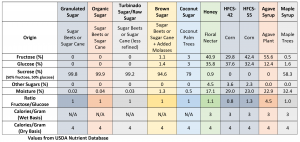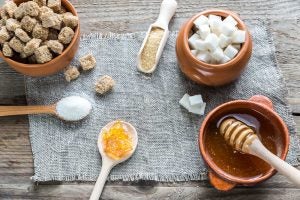Inevitably at this time of year, there’s bound to be misinformation floating around social media about sugar and candy and how “toxic” it is. Of course, there are those like Food Babe that recommend you switch out your children’s “toxic” Halloween candy with safer and healthier organic alternatives. I’m sorry if you’ve been duped into believing that organic sugar or coconut sugar is somehow better for you than regular granulated sugar or even high fructose corn syrup, but it’s not. Yes, I said high fructose corn syrup. Let’s compare them based on the actual chemistry and evidence, shall we?
In previous articles here and here, I covered off on food additives and how natural colors and flavors aren’t necessarily safer or more nutritious than synthetically derived colors and flavors, so we already know that even if the organic versions of our favorite Halloween candies are different in this way, it doesn’t make them safer or healthier. Another argument you may see is that these “natural” or organic versions are made with better or more natural forms of sugar, such as agave syrup, coconut sugar, or organic sugar, but are these versions really healthier, or is sugar just sugar?
Here are some of the most common forms of sugar you’d see on a candy label or that you’d typically bake with: granulated sugar, organic sugar, coconut sugar, honey, high fructose corn syrup (HFCS), brown sugar, agave syrup, maple syrup and raw/turbinado sugar. Each of these versions of sugar are going to have around 4 calories per gram on a dry weight basis. Since wet ingredients like honey and syrups have a bit more moisture than the dry sugars such as granulated sugar, the amount of calories per gram is slightly lower, however, per gram of actual sugar (dry weight basis) the calories are the exact same and all are considered to be added sugars. Another argument that may arise is that the more unrefined versions of sugars have additional nutrients, which can be true, but in order to get a significant amount you’d have to eat quite a bit of sugar in the process.

A common misconception is that HFCS is “high” in fructose compared to most sweeteners, but the truth is that it’s only “high” in fructose compared to the corn syrup it was derived from, which is purely glucose. You can see on the table above that HFCS-55 contains a similar ratio of fructose to glucose as both sugar (sucrose) and honey, and HFCS-42 is even lower in fructose than all of the other options. Pure sucrose is 50 percent fructose and 50 percent glucose, which is chemically bound. This chemical bond is rapidly broken down by the sucrase enzyme in the intestine, which releases fructose and glucose for absorption. HFCS often gets confused with pure fructose, which it is not.
The claim that fructose is “toxic” is based on rodent studies that examine acute effects of incredibly high doses of pure fructose. Obviously this isn’t evidence of HFCS or even fructose being “toxic” or harmful to humans when consumed in realistic amounts because 1) we aren’t mice, 2) the doses used were many times more than humans would consume from foods, 3) HFCS is not pure fructose, 4) we typically consume these sweeteners in conjunction with other ingredients, and 5) HFCS contains similar or even lower amounts of fructose as regular sugar, honey, or the other forms of sugar listed above, so one would not expect HFCS to be any worse as compared to other types of sugar.

In fact, the studies comparing intake of sucrose, HFCS, and other similar sweeteners such as honey have found they exert similar metabolic effects. Even Michael Pollan, author of In Defense of Food and The Omnivore’s Dilemma, who has played a large part in damaging the sweetener’s reputation, has changed his stance after learning more about the chemistry of it and looking at the research. He was asked about the dangers of HFCS in a 2017 interview with the Cleveland Plain-Dealer, and clarified his current thinking: “I’ve done a lot to demonize it,” he says. “And people took away the message that there was something intrinsically wrong with it. A lot of research says this isn’t the case. But there is a problem with how much total sugar we consume.”
Perhaps he should look into the research on the other food-related topics in which he spreads quite a bit of misinformation, too.
So, what’s the bottom line? There’s really no need to swap out your favorite sweet treats with the “natural” or organic and arguably less enjoyable candies this Halloween season. Sugar is sugar for the most part, and all of these forms of sugar are considered to be “added sugars,” which can be enjoyed by most people in moderation. And as always, if someone is claiming that a food product is “toxic” yet they can’t specify the chemical, the concentration in the food, AND the toxic dose, they’re either clueless, trying to deceive you, and/or are trying to sell you something.
Food Science Babe is the pseudonym of an agvocate and writer who focuses specifically on the science behind our food. She has a degree in chemical engineering and has worked in the food industry for more than decade, both in the conventional and in the natural/organic sectors.



